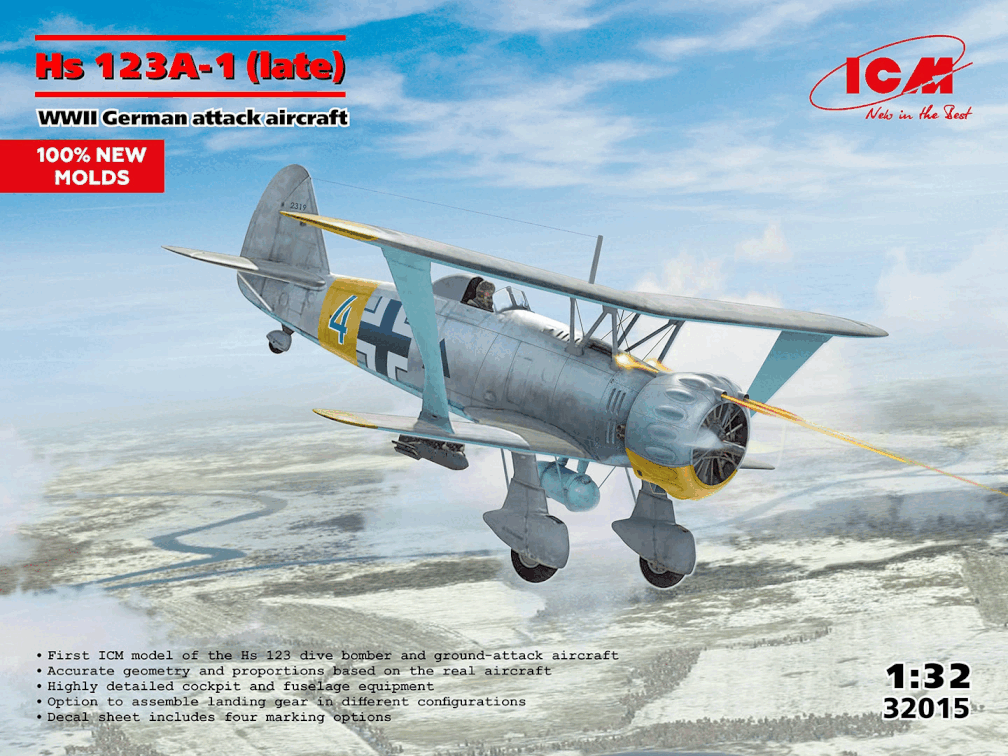ICM has released five interesting kits for July. Something for both small & large-scale aircraft modellers & German soft skins in 35th in our preview...
Preview: ICM's five releases for July...
Hs 123A-1 (late), WWII German attack aircraft
(100% new moulds).
From ICM Models
1/32nd Scale
Kit No: 32015
Length/Wingspan 272 mm/330 mm
Kit parts: 201 pcs
In 1933, at the initiative of the German Reich Ministry of Aviation, development began on a specialized dive bomber. In the spring of 1935, the prototype developed by Henschel Flugzeug-Werke A.G. made its first flight. This prototype was designated Hs-123 V1. The aircraft received positive evaluations, and in September 1936, serial production of the Hs 123A-1 modification commenced. The new attack aircraft was equipped with a BMW 132 engine, delivering 880 horsepower at takeoff.As its built-in armament, it carried two synchronised machine guns mounted behind the instrument panel, firing through special ducts in the engine cowling. The lower wing, fitted with flaps, had four hardpoints for 50-kg bombs, and a single 250-kg bomb could be mounted under the fuselage.
The Hs 123s were deployed with units assigned to direct infantry support, and they were also widely used in training units. At the start of World War II, these aircraft were used during the invasion of Poland and shortly after in France and the Balkans, where they demonstrated high survivability against anti-aircraft fire, even withstanding direct hits. Later, the Hs 123 saw action in Luftwaffe units during operations against the Soviet Union. Despite its outdated design, the aircraft remained in service with the German Air Force until as late as 1944.
Hs 123A-1 Legion Condor
(100% New Moulds)
From ICM Models
Kit No: 32016
1/32nd scale
Length/Wingspan 272 mm/330 mm
Kit Parts: 197 pcs
In the summer of 1936, a civil war broke out in Spain. During this conflict, Germany supported the Nationalists by secretly supplying them with weapons. Between the autumn of 1936 and the spring of 1937, five Hs 123A aircraft were sent to Spain for combat trials and were assigned to the experimental unit VJ/88 of the Condor Legion.Although officially classified as fighters, these Hs 123A aircraft were primarily used in the ground-attack role. Their first combat operation was during the battles for Málaga. As close air support aircraft, the Hs 123s performed excellently, demonstrating high survivability and the ability to operate from short, unprepared airstrips.
They showed an outstanding balance of speed and manoeuvrability—when damaged, the Hs 123 could escape enemy fighters by diving steeply. Out of the five aircraft deployed, three were lost in action, while the remaining two were later transferred to the Nationalist air force. In 1939, Spain ordered an additional twelve Hs 123 aircraft, which remained in service until 1949.
F-16AM of Ukrainian Air Forces with PAG-14
From ICM
Kit No: 72145
1/72nd scale
The F-16 Fighting Falcon is the most widely produced lightweight fighter aircraft in the world. As of 2018, a total of 4,604 units had been built, and it was operated by air forces of more than 30 countries. Developed in 1974 by General Dynamics, it was notable for its high degree of standardisation in parts, assemblies, and systems. Over its service life, the F-16 has undergone several upgrades to remain frontline capable. Since August 2024, the Air Force of Ukraine has received multirole F-16 fighters. Ukrainian F-16s can employ AIM-9 and AIM-120 missiles, as well as precision-guided bombs such as SDB, JDAM-ER, and GBU-39. A key feature is their use of ECIPS+ electronic countermeasure pods to disrupt enemy radar systems. The first reports of Ukrainian F-16s being deployed appeared in late August 2024, when the aircraft participated in repelling a large-scale missile and drone attack. By winter 2025, these jets were also conducting strikes on ground targets using GBU-39 precision bombs.
G917T Truppenluftschutzwagen
From ICM Models
Kit No: 35408
1/35th scale
Length 189 mm
Number of parts: 186 + 89 pcs
A large portion of the Wehrmacht’s truck fleet during World War II consisted of 3-ton cargo vehicles. One such model was the G917T, produced at Ford’s Cologne plant from 1939. These trucks served across many army units and fronts until the end of the war. Between 1939 and 1941, approximately 25,000 G917T trucks were built.Parts for the truck
Some were converted into improvised self-propelled anti-aircraft platforms, mounting 2 cm Flak 38 guns in their cargo beds. For firing, side panels were folded down or removed. The Flak 38 entered Wehrmacht AA service in late 1940. With a reliable design and up to 480 rounds per minute, it was effective against aircraft and lightly armoured ground targets.
Parts for the Flak 38
Vehicles of the D.A.K (s.E.Pkw Kfz.70 with Zwillingssockel 36, Typ L3000S, le.gl.Einheitz-Pkw Kfz.2)
From ICM Models
1/35th scale
(Three kits inside)
Kit No: DS3529
The German Afrika Korps (D.A.K) was formed in winter 1941 for the North African Campaign. From February 1942, alongside Italian forces, it became part of Panzer Group “Africa” under Erwin Rommel. The D.A.K maintained a large motor pool, including the Mercedes-Benz L3000, a 3-ton cargo truck, and the s.E.Pkw Kfz.70 (a Horch 108 Typ 40 variant) fitted with the Zwillingssockel 36 twin-mount MG 34 for AA and infantry support. Also in use was the le.gl.Einheits-Pkw, a light multipurpose all-terrain vehicle built by Stoewer, BMW, and Hanomag from 1936. One configuration, the Kfz.2, served as a three-seat radio communication vehicle equipped with a Torn.Fu.b1 set.
Due in next month, you can find out about ICM's other releases on the ICM plastic model kits website



,%20WWII%20German%20attack%20aircraft%20(1).webp)
,%20WWII%20German%20attack%20aircraft%20(3).webp)
,%20WWII%20German%20attack%20aircraft%20(4).webp)
,%20WWII%20German%20attack%20aircraft%20(5).webp)
,%20WWII%20German%20attack%20aircraft%20(6).webp)
,%20WWII%20German%20attack%20aircraft%20(7).webp)
,%20WWII%20German%20attack%20aircraft%20(8).webp)
,%20WWII%20German%20attack%20aircraft%20(9).webp)
,%20WWII%20German%20attack%20aircraft%20(10).webp)
,%20WWII%20German%20attack%20aircraft%20(11).webp)
,%20WWII%20German%20attack%20aircraft%20(12).webp)
.webp)
.webp)
.webp)
.webp)
.webp)
.webp)
.webp)
.webp)
.webp)
.webp)
.webp)
.webp)
.webp)
.webp)
.webp)

.webp)
.webp)
.webp)
.webp)
.webp)
.webp)
.webp)
.webp)
.webp)
.webp)
.webp)
.webp)
.webp)
